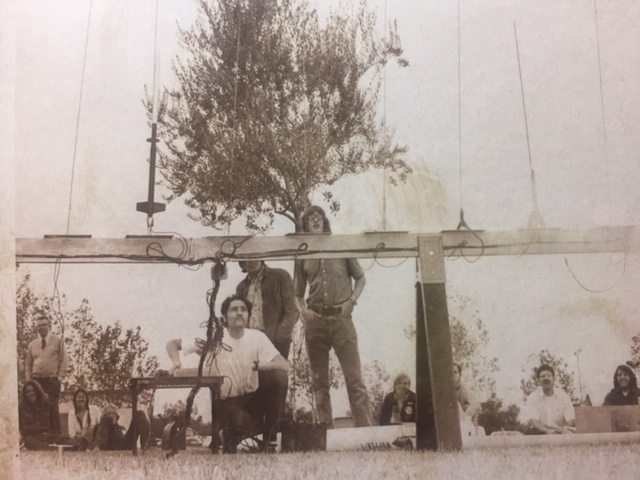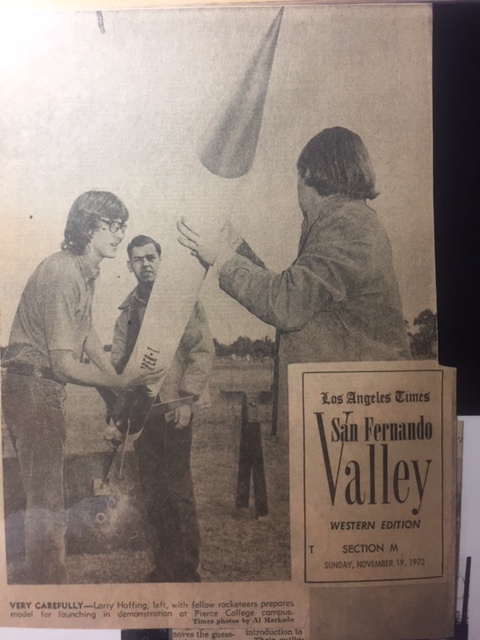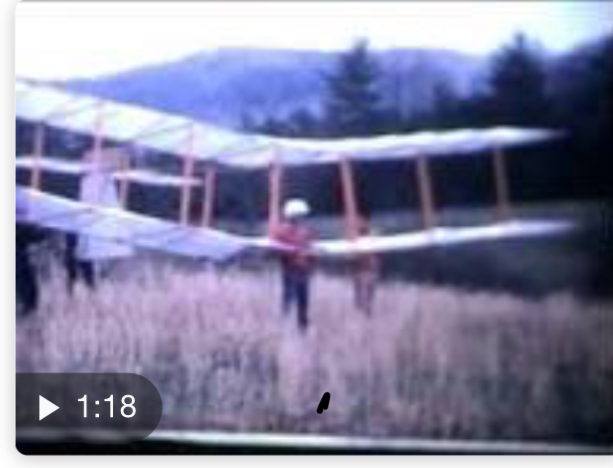Dave Nordling, Reaction Research Society
The RRS held a launch event at our Mojave Test Area (MTA) on March 20, 2021, the spring equinox. COVID-19 still remains a threat so everyone had to observe protective protocols. We had a lot of wind that day making launch impractical, but we still were able to get many things done that day including another static fire of a hybrid motor, some system checkouts of the Gas Guzzler and a possible flight of the Solar Cat steam rocket. Osvaldo Tarditti was our pyrotechnic operator in charge. Also joining us that day was fellow Rockets 2nd Class pyrotechnic operator and RRS member, Jim Gross,
MOBILE TRAILER CLEANUP
Mike Gottlieb was a lifetime member of the RRS who passed away over 2 years ago. Years prior, he had acquired a surplus mobile trailer from the former Rockwell International company which was left to reside at the RRS MTA. By permission from his surviving family, this single-axle, climate controlled trailer has been donated to the society. The trailer was opened by the RRS president and the interior inspected by our members present at our March 2021 launch event.



For now, the space will be used for light storage until more space can be acquired elsewhere. We used the time to reorganize the contents of our storage trailer. We hope to renovate this new mobile trailer soon and restore its climate control systems which will be convenient in the summer months.
PUBLIC ADDRESS SYSTEM AT THE MTA
During the cleaning and reorganization of our storage space, we pulled out the public address equipment we had. The 12 VDC battery powered system including loud speaker and microphones worked well in a test from the old blockhouse. The society has talked about having a more distributed system around the main areas of the site. This will require some further equipment purchases, but for now we have a core system to start from. The goal is to make coordination of our events easier to do when we have large groups of people at the MTA again. Further still, we’d like to coordinate launch timing better with our neighboring amateur rocketry group (FAR) to our south.

NEW RESTROOM FACILITY
As discussed at the March 2021 monthly meeting, the society is going forward with building a new restroom facility with flushing toilets. This will be a big convenience to our visitors and members alike. The executive council has received bids and plans for the restroom and is working with suppliers to find the best solution given our budget. We are grateful to our generous benefactor and the many people who supported this project with their time and skills. More progress should be made soon as we would like to deploy this facility before the hot summer months arrive this year.

FIRST FLIGHT OF THE SOLAR CAT FROM THE MTA
Bill Inman and new member Jonathan Wells returned to the MTA for another attempt to launch the solar powered steam rocket, the Solar Cat. He has been making many adjustments and had his first launch near his home in Carson City. Today would be his first launch of his Solar Cat from the MTA.

Bill was able to work out minor problems on his trailer mounted systems last month and was fully ready to use his solar heating and tracking system for the hours necessary to reach launching temperatures of the stored water load in his steam rocket.
Bill has had some minor problems with the release system which led to a unintended release of the rocket. No one was injured but it did cost him several useful hours for insolation (heating). His second attempt was only a partial heat load but sufficient to conduct the first (technically second) flight at the MTA. Keith Yoerg managed to capture the short flight in the late afternoon. It’s a bit comical to watch given how short the flight was, but it is a significant milestone in getting this non-traditional form of liquid propulsion to work. We look forward to the advancements, Bill will make for future flights from the MTA.



REBUILD AND SYSTEMS CHECK OF THE GAS GUZZLER
Wolfram Blume had made several improvements since his last flight attempt of his two-stage ramjet-solid motor rocket. He was able to correct software issues but also made physical feature changes to his booster. Wind speeds were excessive for much of the day, so he used his time at the MTA for fit checks while on the 1515 rail launcher.


Wolfram was able to conduct his tests making use of the 1515 rail launcher. He left in the afternoon after completing his tests and will return for our next launch event planned for April 10. 2021.
WIRELESS FIRE CONTROL AT THE MTA
Wireless fire control is a remote means of conducting launch without stringing long wire connections. This has been a controversial subject at the RRS with some of our members actively supporting using these systems and others being skeptical about their safety.
Richard Dierking mentioned the Wilson F/X wireless firing system which has been used at the Rocketry Organization of California (ROC) and at the Friends of Amateur Rocketry (FAR) site. Fellow RRS member, Dmitri Timohovich, has used Cobra Firing Systems for pyrotechnic events in the movie business with success. He brought one of these systems to demonstrate at the MTA with test bulbs. The 64-bit encryption in this system vastly reduces the possibility of stray signals causing an unintended firing.

A decision was made at the March 2021 meeting to proceed with care by testing one of these wireless fire control systems with only low-power simple model rockets. We also thought meeting with a sales representative or technical advisor from a wireless fire control system manufacturer to explain the safety of these systems to the society would be an excellent idea. Some of our members have had a negative experience with these systems with unintentionally firing. Older wireless fire control systems have had safety issues. Safety in operations with pyrotechnics of any kind is of paramount importance.
wilsonfx.com
cobrafiringsystems.com
The RRS plans to educate themselves further about wireless firing system technology before making any further policy decisions. It is agreed that every pyro-op in charge at the event has the final say about what systems are and are not allowed at the event. The best course of action for any project leader is to discuss all aspects of their test or launch with the pyro-op in charge well in advance of the event at the MTA.
STATIC FIRING OF THE HYBRID MOTOR
The last two firings of the Contrails H222 38mm 16-inch hybrid motor left some questions about how reliable the ignition of the motor is. From both prior flights, it was evident that quick severance of the nylon plastic fill line at the launch command was not happening. Altitude was very low from such a powerful motor according to the curve. Since the last flight damaged the rocket body beyond repair, the next firing was intended to watch the startup sequence in careful detail under static conditions.
The motor survived in tact from the last short flight, The nozzle, spent grain and floating injector were shoved forward from the impact, but all parts were able to be removed, cleaned and reassembled for another firing with the last of my three fuel grains from the kit.

The static test firing was done on the vertical test stand using a simple wooden fixture and 1/2-inch fasteners. The fixture was built quickly and unfortunately not perfectly. We had to fire the motor upside-down which is not representative of how the engine flies.



The igniter used in the 3-20-2021 test used an electric match as was done in the second test. The kit comes with an electric resistor. In the first test, this was insufficient to get ignition and sever the fill line. Second firing used an electric match and a fragment of composite propellant. This achieved ignition but the fill line wasn’t fully severed. The third attempt used a similar load with a bit more composite propellant. The idea was to produce an ignition flame hot and fast enough to soften and sever the pressurized nylon fill line, With the escaping oxidizer liquid, the combustion should be enhanced and help sever the line. In practice, this doesn’t seem to occur quickly enough,
In the hybrid firing that day, the igniter fired and some chuffing from the nozzle was seen but the combustion was not sustained and the oxidizer supply emptied. The motor will be disassembled and inspected to see if all the composite propellant was consumed or if the nitrous oxide dispersed the pack before the full burn could finish.




MORE WATER ROCKETS
Dmitri upgraded his water rocket launch system to fire multiple rockets. He had a remote firing box which made it very easy to set up. The winds were too strong for any high altitude flights, but the modest water rockets were plenty of fun.

MODEL ROCKETS
The Yoerg Challenge started as a simple request to those attending our meeting on March 12, 2021 before the launch event: build as many model rockets from as many people as possible and launch them from the multi-wire launcher array that Keith built last month. Dmitri and I both answered the challenge for the event, Although many of our members have built many model rockets since they were kids, some of have not. For those experienced and inexperienced, the Yoerg Challenge was issued. More rockets at each successive event inspires others to build more rockets and more ambitious rocket builds. The RRS is for all forms of reaction propulsion even with a simple model kit.



At the end of the day, Keith and Dmitri launched their model rockets using small “A” sized motors to keep their altitudes low and avoid being carried far downrange with the high winds. I decided not to fly my first model as I left early that day. We hope others will build and bring theirs at our next event.
IN CONCLUSION
Next launch event will be April 10, 2021, with USC and member projects.


















